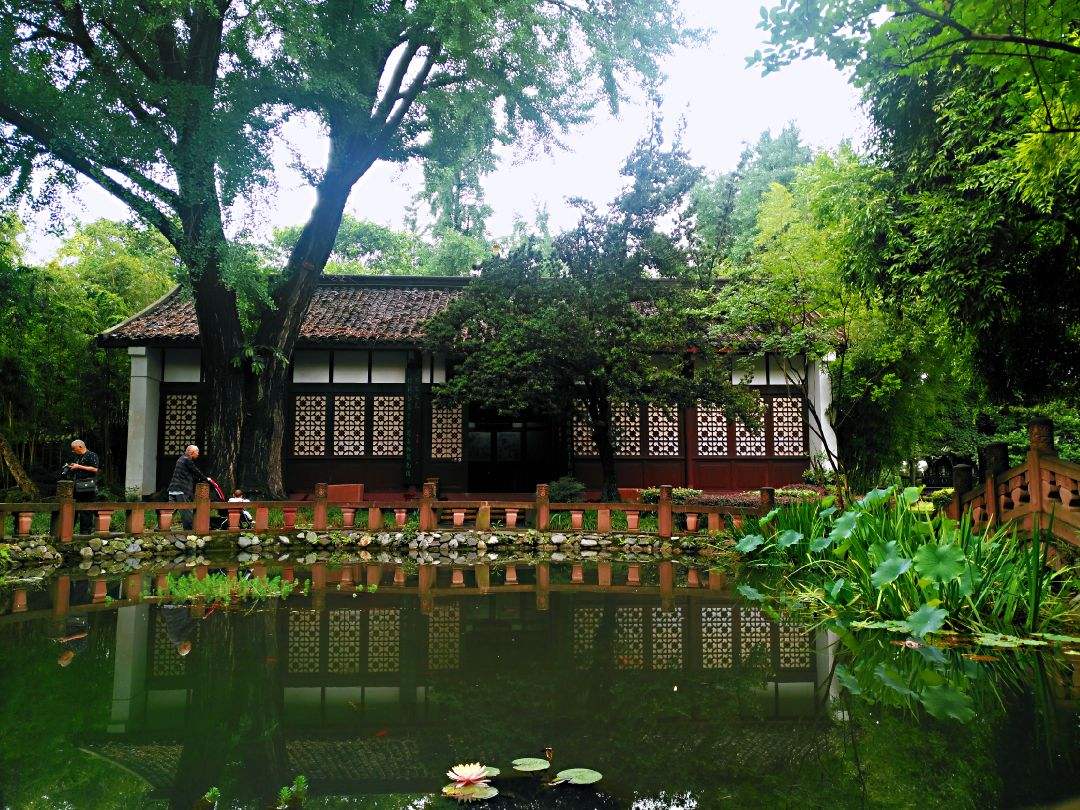Chinese Name: 望江楼公园 Pronunciation: wàng jiāng lóu gōng yuán
Building Time: 1889
Recommended Time for Visit: 2-3 Hours
Best Visiting Season: March to May, September to November
Occupied Area: About 188mu (125,000 square meters)
Address: No.30, Wangjiang Road, Wuhou District, Chengdu City, Sichuan Province
Popular Activities: Local people do morning exercises and practicing Tai Chi; an Internet-famous site for photography
Building Function: Wangjianglou Park was built to commemorate Xue Tao, a famous female poet of the Tang Dynasty.
| Park Areas | Historic Relic Areas | Open Park Areas |
| Ticket Fare | 20 yuan | Free |
Free for children younger than six years old or under 1.3 meters.
| Park Areas | Historic Relic Areas | Open Park Areas |
| Opening Hours | 8:00-18:00 | 6:00-21:00 |

Located on the south bank of the Jinjiang River and Jiuyan Bridge of Chengdu, Sichuan, Wangjianglou Park was built in an area of lush bamboos, covering about 125,000 square meters. You will enjoy its beautiful landscape and wonderful architecture wherever you go. The main buildings in the park include Chongli (grand and beautiful in Chinese) Tower, Zhuojin (washing brocade) Tower, Huanjian (paper-washing) Pavilion, Wuyunxian (five fairy clouds) Hall, Liubei Pond, and Quanxiang (fragrance of spring) Pavilion.
Wangjianglou Park was built in the Ming and Qing Dynasties (1420-1912) to commemorate the female poet Xue Tao of the Tang Dynasty. At present, it is a famous scenic spot in Chengdu, a representative of Sichuan classical gardens, an important heritage site under state protection, and a renowned Chinese garden.
Walking around the open park areas, you will notice the engaging garden landscape mainly composed of bamboos. A major feature of the park is its varieties of bamboos. The combination of various kinds of bamboos brings Wangjianglou Park a new name, Bamboo Park.
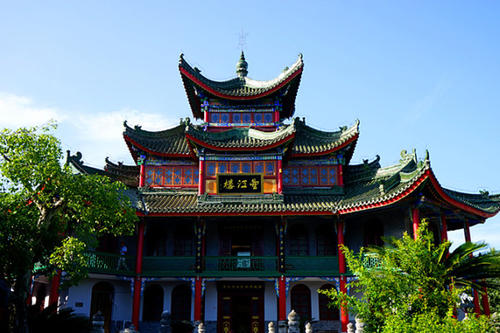
Wangjianglou Park features its earliest bamboo collection and boosts the longest history of human bamboo cultivation in China. Since 1954, bamboo has been introduced and cultivated here. After 65 years, more than 400 kinds of living bamboos belonging to 34 genera have been protected and cultivated. Of all types of bamboos, three types are endangered, five are rare, and another five belong to vulnerable species. Four new species in the park have been identified. Now Wangjianglou Park serves as an important gene bank of bamboo germplasm resources in China.
On February 13, 2018, Chinese President Xi Jinping came to Sichuan for inspection and delivered the important directive spirit: “Wangjianglou Park, with famous bamboos, has made bamboo in Sichuan a lot more cultural.”
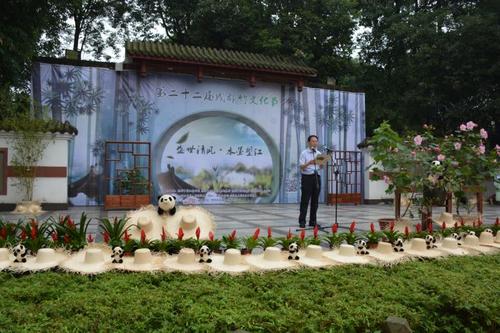
Under the influence of bamboo culture, Chengdu Bamboo Culture Festival is held in Wangjianglou Park every year. Started in 1993, it is one of the traditional cultural garden exhibition festivals in Chengdu, Sichuan Province. When the festival is coming, more than 200 kinds of beautiful bamboo art scenic spots will gather in Wangjianglou Park from Beijing, Shanghai, Yangzhou, and many other places. Besides, visitors can also enjoy 33 groups of large bamboo and flower scenic spots, including more than 120,000 seasonal flowers and foliage plants.
During the festival, cultural activities such as Xue Tao Culture Week, Tea Culture Week, and Health Culture Week, will be held. All these efforts are made to ensure that tourists enjoy the feast of bamboo culture and get more cultural and artistic influence at the same time.
Xue Tao Paper, invented by the female poet Xue Tao, is made for poem writing. It bears 1200 years of history and takes an important position in the history of papermaking in China. Since its creation, Xue Tao paper had been made in the following dynasties. In the Ming Dynasty, the Duke of Shu fetched water from Xue Tao Well to make Xue Tao Paper. However, only a small number of Xue Tao paper were made every year as tributes to the emperors.
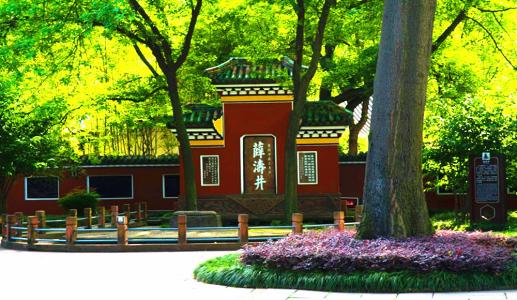
In the early 1950s, the production of Xue Tao Paper was resumed in Wangjianglou Park, but the techniques were not open to visitors.
In order to explore the cultural connotation of Wangjianglou Park and increase the tourism value and sightseeing content, the Xue Tao Paper workshop in the park began to open to tourists and show its production process at Huanjian Pavilion. Tourists can see the production of Xue Tao Paper and how rubbings of poetry stele are made.
During the tour, visitors will enjoy the traditional printing process of Xue Tao Paper. At the same time, with the help of the staff, they will have an opportunity to experience the processes of making Xue Tao Paper and rubbings themselves to feel the charm of traditional culture.
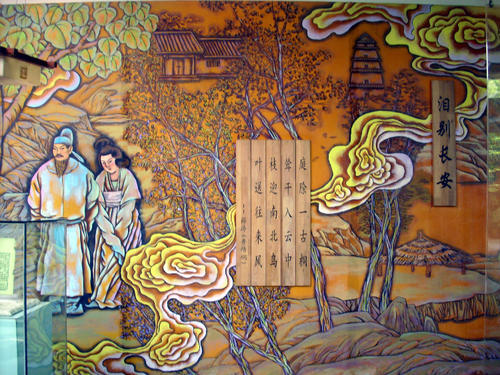
In order to sort out and inherit the excellent history and culture in Chengdu, researchers considered it important to make Xue Tao, the talented patriotic poet who lived in Chengdu for many years, a beautiful and elegant city card. The Chengdu Xue Tao Research Association shot a microfilm “Legend of the Talented Woman Xue Tao in the Tang Dynasty” in 2014 to promote the great development and prosperity of Chengdu culture. The 25-minute film showed Xue Tao’s life story and her talent in music and poems.
In 1814, Yinshi (poems-chanting) Building, Huanfa Pavilion, and Zhuojin Tower were constructed.
In 1889, Chongli Tower was set up.
In 1898, Wuyunxian Hall, Pipa (loquat) Alley, and other spots were built.
In 1928, the “Suburban First Park” was established.
In 1952, the government allocated special funds for the renovation of the park.
In 1953, the park was renamed Wangjianglou Park and officially opened to the public in November.
In 1960, the park was enlarged.
In 1984, Xue Tao’s Statue was set up in the park.
In 1994, Chongli Tower was rebuilt and the tomb of Xue Tao was built.
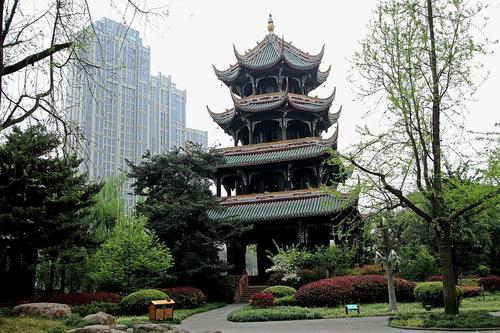
Chongli Tower (Wangjiang Tower) is also known as River Watching Tower. Chongli Tower, built in 1889, is a landmark building to manifest Chengdu’s rich culture and long history. Since it is near the Jinjiang River, people also call it River Watching Tower.
According to the historical records, the predecessor of Chongli Tower is Huilan (Whirling waves) Tower. It was destroyed in the war in the 17th year of Emperor Chongzhen’s reign (1628-1644) of the Ming Dynasty. Since then, the literary development in Sichuan province had been stagnant, so this building was built to follow and inherit the style of writing in Sichuan.
In China, Wenquxing (文曲星) is the god in charge of official fortune. In response to the wishes of the local people, the artwork of “Wenquxing” is now dedicated to the second floor of the tower for tourists. People often visit and pray for good luck and success in career and academics.
River Watching Tower, 27.9 meters tall, is the most magnificent building in Wangjianglou Park. Its ridges and sparrow braces (parts of roof frame) on each floor are decorated with exquisite clay sculptures of animals and figures. Its top is golden and glittering under the blue sky. The tower is magnificently decorated with ingenious designs, colorful paintings, and refined cornices. The unique feature of the building lies in its architecture. You can see that the tower has four floors. The first and second floors are open to four directions, and the third and fourth floors face eight directions, implying “sì píng bā wěn” (四平八稳, everything goes well).
When you climb the tower, a panoramic and natural view of the Jinjiang River is in front of your eyes. Overlooking the combination of Wangjiang Tower, Yinshi Building, Zhuojin Tower, and Wuyunxian Hall, you will be engrossed in the beauty of building clusters with the strong Sichuan garden style.
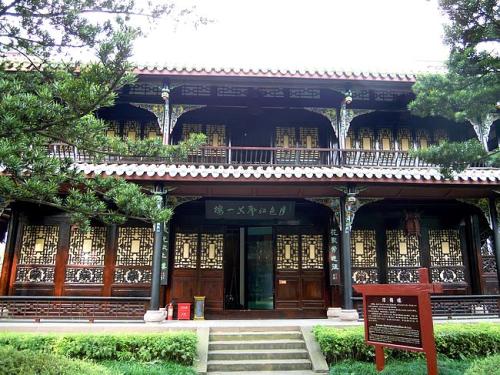
Zhuojin (washing brocade) Tower is located on the west side of Chongli Tower. The name of the building comes from the Jinjiang River. In the Han Dynasty (202BC-220AD), brocade households in Chengdu often washed the silk brocades in the Jinjiang River, so the Jinjiang River was also known as the Zhuojinjiang (washing brocade) River for such a function. As a result, it got the name Zhuojin Tower.
It was first built in 1814, during the reign of Emperor Jiaqing (1796-1820) in the Qing Dynasty, and was destroyed later by war. In 1898, it was rebuilt as today’s Zhuojin Tower. The tower is in the shape of a boat and has two floors and three rooms. It is said that the tower was built to express Xue Tao’s dismay for her friend Yuan Zhen.
The furniture displayed inside the tower was made during the Ming and Qing Dynasties and has been well-preserved for many years. Most of them were made in the Qing Dynasty. The essential craftsmanship in furniture of the Qing Dynasty mounted the peak at that time. It is characterized by magnificent shape and exquisite carving.
Moreover, furniture carving mostly expresses auspiciousness and best wishes with homophony. For example, bat reads “Fu” in Chinese, representing good luck, and deer pronounces “Lu”, implying more income.
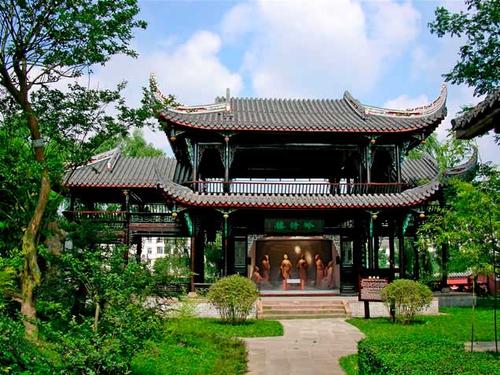
Yinshi (poems-chanting) Building is located in the east of Chongli Tower and copies the structure of an old building where Xue Tao lived in her later years. It was first built in 1814 and reconstructed in 1898. The building is open on all sides and has three floors.
Looking southwest from Yinshi Building, you will see Pipa (loquat) Alley constructed following a loquat-related poem for Xue Tao. Passing through Pipa (loquat) Alley, you will arrive at other memorial buildings, including Wuyunxian Hall, Quanxiang Pavilion, and Huanjian Pavilion.
He Shaoji, a famous calligrapher of Sichuan in the Qing Dynasty, wrote a couplet for this building, which is now hung on the second floor. Meanwhile, Guan Shanyue, a famous modern painter, also painted a picture from Yinshi Building, and the work is preserved in the building.

Huanjian (paper-washing) Pavilion was built in 1898. The inscription “浣笺亭” (paper washing pavilion) on the horizontal board of the gate was written by a famous local calligrapher Zhao Yunyu. The pavilion was built to remember the place where Xue Tao used to make paper.
In the early years of the Tang Dynasty, the larger paper was often used to copy lengthy Buddhist scriptures. It was often wasteful to use this kind of paper to write poems. Therefore, Xue Tao made a kind of pink and narrow paper for the purpose, and later this kind of paper was called Xue Tao Paper.
Xue Tao is not only famous for her talents, but also her excellent contribution to the cause of Chinese culture. In Huanjian Pavilion, you will find the art of papermaking in the Tang Dynasty.
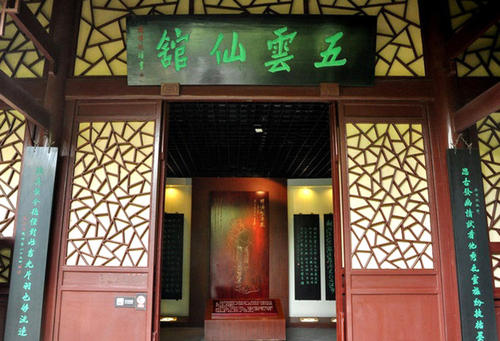
Wuyunxian (five fairy clouds) Hall was built in 1898. The hall was named after one of Xue Tao’s poems. She had written more than 500 poems in her life, and only about 90 poems have been preserved so far. She was a great female poet in ancient times with the most works preserved today. In Wuyunxian Hall, 39 copies of Xue Tao’s most representative works by famous calligraphers were stored.

Sichuan bonsai is a national intangible cultural heritage and is one of the five major schools of bonsai in China. It has its own style of plastic arts, and the combination of bamboo and stone bonsai is one of the major innovations of Sichuan bonsai.
The bamboo stone bonsai in Wangjianglou park is one of the characteristics of Sichuan bonsai. Bamboo and stone bonsai are organically integrated into a whole artwork, reflecting the natural beauty, creative skill, and connotation beauty of bamboo and stone landscape. In the studio, visitors can have a hands-on experience of the national intangible cultural heritage.
Xue Tao was high-born in the Tang Dynasty and raised in the capital Chang’an (today in Xi’an, Shaanxi). She was smart and well-educated when she was young. Because of political factors, all her family members were banished to Chengdu. After her father’s death, she became a singer at a low social status because of her poor family.
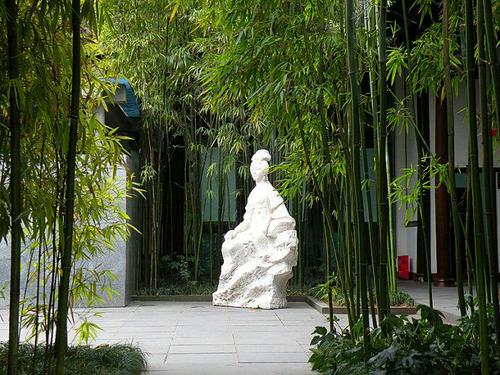
Luckily, as she was good at poetry, writing, and proficient in rhythm, a governor appreciated her talents and recommended her to work for the authorities. Since then, she became famous nationwide with her outstanding performance.
According to records, she had written more than 500 poems and shared a high reputation among many well-known poets in the Tang Dynasty, such as Bai Juyi, Liu Yuxi, and Du Mu. However, most of her poems have been lost, leaving about 90 poems today.
In 809, a young influential poet Yuan Zhen, who heard much about Xue Tao, arrived in Sichuan and met her. Then, they fell in love with each other. However, after three months’ happy life together, Yuan Zhen was ordered to leave Sichuan by the authority. Their separation was inevitable. Xue Tao was very sad and helpless.
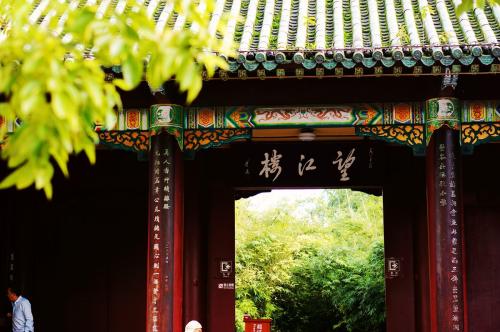
The good news was that she once received a letter filled with love from him. To show her feelings, she reformed the local papermaking process, dyed the paper pink, and cut it into delicate and narrow paper, especially suitable for writing love letters, known as Xue Tao Paper.
But, somehow, Yuan Zhen forgot her and never returned. At the end of her life, Xue Tao gradually got tired of the hustle and bustle in the world. She built the Yinshi Building to spend the rest of her life.
Enter from South Gate of the Park→Open Park Areas→Wangyue (admiring the moon) Pavilion→Yinshi (poems-chanting) Building→Wuyunxian (five fairy clouds) Hall→Liubei Pond→Chongli (grand and beautiful in Chinese) Tower→Xue Tao Well →Zhuojin (washing brocade) Tower.
North Gate and West Gate: Take bus 19, 256, 1107, and get off at Wangjianglou Park Station. (The station is closer to North Gate)
South Gate: Take bus 19, 256, and get off at Gongyuanlu Zhongduan Station.
Chinese: 请带我去望江楼公园。English: Please take me to the Wangjianglou Park.
Chinese: 请带我去望江楼公园北门。English: Please take me to the North Gate of Wangjianglou Park.
Chinese: 请带我去望江楼公园的西门。English: Please take me to the West Gate of Wangjianglou Park.
Chinese: 请带我去望江楼公园的南门。English: Please take me to the South Gate of Wangjianglou Park.
(Tips: The South Gate of Wangjianglou Park is the front gate of the park and sells tickets for Historic Relic Areas.)
If you go to Wangjianglou Park from the center of Chengdu City (Rhombus Park Aura Chengdu Hotel), it takes about 10 minutes (about 12 yuan).
If you go to Wangjianglou Park from Chengdu Shuangliu International Airport, it takes about 30 minutes (about 50 yuan).
If you go to Wangjianglou Park from Chengdu East Railway Station, it takes about 20 minutes (about 20 yuan).
